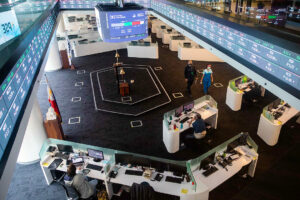By Bjorn Biel M. Beltran, Special Features and Content Assistant Editor
Though the Philippine economy remained robust in the face of global headwinds last year, for many, expectations had been tempered regarding its prospects. For the whole year, gross domestic product (GDP) growth was recorded at 5.6%, failing to meet the lower end of the government’s annual target of 6%. If the historic decline of 9.5% in 2020-pandemic year were to be discounted, 2023 was the slowest growth the economy has had since 2011.
The sentiment bled up to the first quarter of 2024, with the Bangko Sentral ng Pilipinas (BSP) noting that business sentiment in the country turned less upbeat as the overall confidence index (CI) declined to 33.1% from 35.9% in Q4 2023.
“This is reflective of the combined decrease in the percentage of optimists and increase in the percentage of pessimists. The Q1 2024 CI turned less buoyant due mainly to the firms’ concerns over the: (a) post-holiday decline in demand for goods and services, and slowdown in business activities, (b) persistent inflationary pressures stemming from higher food and oil prices, and its impact on the economy, (c) stiff competition, and (d) adverse effects of a strong El Niño event in 2024 on the agriculture sector,” the central bank said in a statement in April.
Cautious optimism seems to be the play for many, as the BSP noted that in the second quarter of 2024, businesses are expecting better prospects in general as the confidence index jumped to 48.1% from 38.2% in the last survey of 2023. More demand for products and services, more project completions due to a better business environment, seasonal boosts in tourism and fisheries, expansions, and lower inflation are all reasons behind this confidence.
Looking further ahead to the next year, the outlook is also much brighter, with the confidence index rising to 60.8% from 54%. This upbeat sentiment is driven by expectations of steady high demand, favorable economic conditions, continued low inflation, business expansions, and lower interest rates.
For the financial industry, banks in particular, opportunities are simmering just below the surface. Global credit ratings agency Fitch Ratings has recently revised the Philippine banking sector’s outlook to improving from neutral, with the firm expecting banks to be able to preserve their record-high net interest margins for longer due to a delay in policy rate cuts.
“This, coupled with a sustained rise in higher-yielding consumer lending and rollout of key infrastructure projects, is likely to buoy banks’ revenue prospects for the rest of 2024. Meanwhile, we believe the extension in higher interest rates will have a manageable impact on the sector’s asset quality given the resilient economy, with Fitch projecting GDP growth of 5.8% in 2024,” the agency said.
Development Bank of the Philippines (DBP) President and Chief Executive Officer Michael O. de Jesus held the same sentiment, saying in an interview that the Marcos administration’s ambitious infrastructure spending plans for the year, including a significant allocation of P1.5 trillion for 2024, highlight the banking sector’s role in financing vital projects such as transportation networks and utilities.
“These investments not only stimulate economic growth but also drive demand for financial services, ranging from project financing to construction loans. Additionally, supporting the expanding manufacturing sector, which recorded robust growth drive by electronics and food products, allows banks to facilitate growth through tailored financial solutions like working capital and expansion loans,” he told BusinessWorld.
Other sectors are also emerging as promising investment opportunities for Philippine banks, such as renewable energy, manufacturing, and the time-tested IT-BPM industry.
“Initiatives in renewable energy, aiming for a substantial share in the power generation mix by 2030 and 2040, offer banks stable investment prospects in solar, wind, and hydroelectric projects, aligning with global trends towards sustainable finance,” he said.
“The dynamic IT-BPM sector, forecasted to grow annually by 7%-8%, presents banks with opportunities to finance technological advancements and expansion initiatives. By offering specialized financial products and services tailored to the sector’s needs, banks can harness this growth momentum to foster innovation and cater to evolving market demands.”
Digital-driven momentum
Another factor playing to the financial industry’s favor is the considerable momentum the Philippines has gathered with regards to its digitalization efforts. Driven by the significant mobile phone and internet penetration among the Filipino population, alongside the rise of digital payment and e-wallet platforms, financial services are more accessible than ever, allowing the unbanked and underbanked to conduct transactions without traditional bank accounts.
“Banks like DBP are actively leveraging digital innovation to expand reach and cater to underserved segments through mobile apps, partnerships with fintechs for solutions like e-wallets, digital lending, and remittances. However, the urban-rural digital divide persists, with many rural areas lacking reliable connectivity and infrastructure,” Mr. de Jesus said.
“Continued efforts in digital literacy, financial education, and collaboration between banks, fintechs, and government are needed to bridge gaps and ensure that inclusive financial services reach the remote communities. While progress has been made, further innovation is required for truly inclusive financial digitalization across the country,” he added, particularly regarding improvements to mobile internet and telecommunications infrastructure for the most remote and far-flung communities of the country.
Banking at a turning point
While significant challenges remain ahead of the Philippine financial industry, such as the sustained high interest rate of 6.5% to curb inflation, heightened geopolitical tensions, and weak growth in economies like China impacting global commodity prices and export-oriented industries, Mr. de Jesus pointed out that the industry itself is at a turning point.
“In the next five years, the Philippine financial industry is set to undergo significant evolution drive by technological advancements and changing consumer behaviors. Digital banking will emerge as a pivotal capability for financial institutions, enhancing customer experience and operational efficiency. As customers increasingly demand for seamless and accessible banking services, the industry will intensify its digital transformation efforts, leveraging technology to remain competitive and meet evolving expectations,” he said.
Technologies will continue to disrupt and leave lasting effects. Generative AI, for instance, can transform financial services by improving customer interactions and backend operations, personalizing customer experiences and streamlining processes like fraud detection and risk management in digital payments. Additionally, there is a growing focus on sustainable finance, driven by regulatory demands and increased consumer awareness. Banks are now incorporating environmental, social, and governance (ESG) criteria into their operations and products, aligning with global trends and creating opportunities for innovation through responsible investing and green financial products.
“Thus, the Philippine financial industry’s trajectory over the next five years will be defined by its embrace of digitalization, the transformative potential of AI technologies, and a commitment to sustainable finance. Banks that adeptly navigate these shifts will not only enhance their market position but also contribute positively to economic growth and societal development in the Philippines.”






